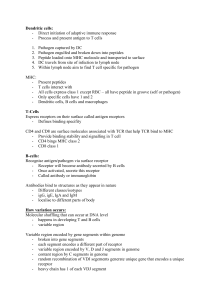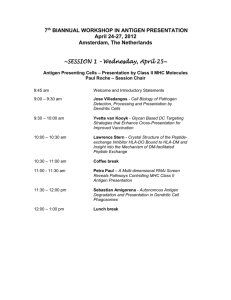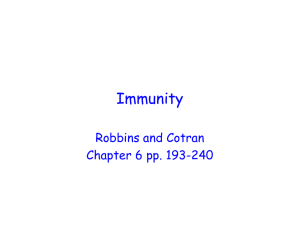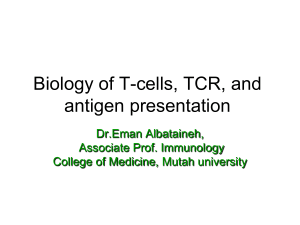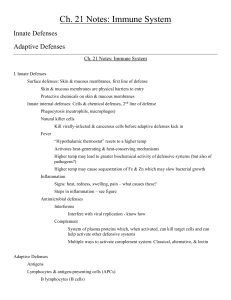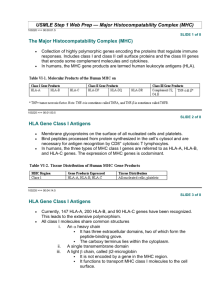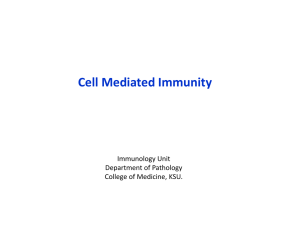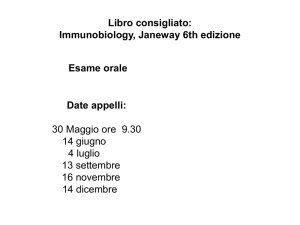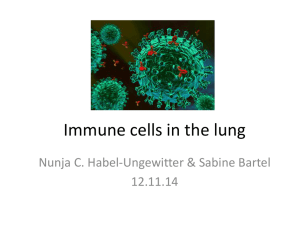B Cell Receptor - Fatchiyah – Molecular Biology
advertisement
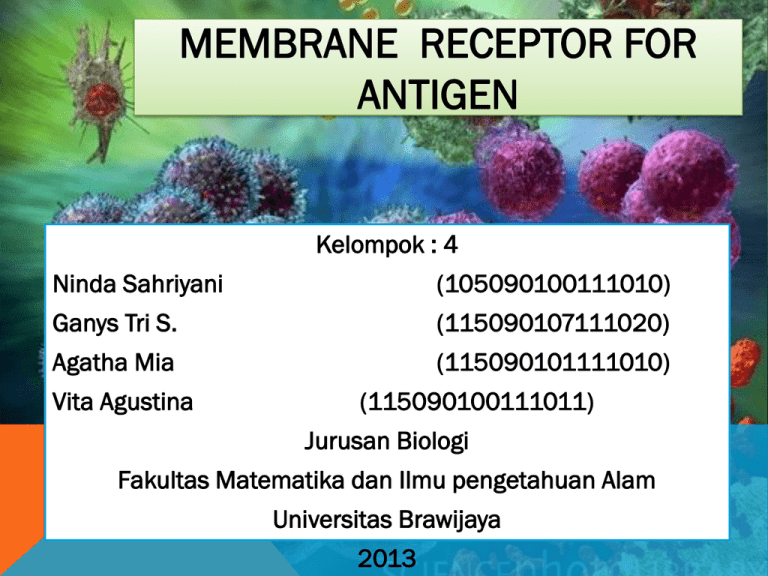
MEMBRANE RECEPTOR FOR ANTIGEN Kelompok : 4 Ninda Sahriyani (105090100111010) Ganys Tri S. (115090107111020) Agatha Mia (115090101111010) Vita Agustina (115090100111011) Jurusan Biologi Fakultas Matematika dan Ilmu pengetahuan Alam Universitas Brawijaya 2013 THREE LIMBS OF IMMUNE RESPONE Fig 1. Three Limbs Immune Respone Major Histocompatability Complex (MHC) • Group of genes that code for proteins that found on the surfaces of cells that help the immune system recognize foreign substances • Also known as HLA (Human Leukocyte Antigen) Two types: Class I Class II • Found in every nucleated cell • Bound to cytotoxic T cell (CD8) • Found in special cell such as macrophage, dendritic cell, B cell, and thymus • Bound to Helper T cell Function of MHC 1. Determinate between the self and nonself antigens 2. Presenting antigen to T cells 3. Determinate interaction between B cells, T cells and other cells. Degradation Process (Processing and Presentation) Antigen There are 3 ways of processing and presentation antigens : 1. Protein from extracellular pathogen broken down and processed by exogen pathway 2. Protein from self-protein and virus protein processed by endogen pathway 3. Lipid and derivate processed like extracelular protein and endosom, with CD1, that similiar to MHC and presented to CD8 T cell. Function of MHC Fig 2. MHC Structures TABLE 1. DIFFERENCES BETWEEN CLASS I AND CLASS II MHC Variable Bound to Class I MHC CD8 T cell Enzyme to form Cytosolic protease peptide Class II MHC CD4 T cell Endosome and lysosom protease Peptide binding site in cell Reticulum endoplasmic Vesicle specialized compartment Peptide size 8-9 amino acid 13-17 amino acid Expression and Presentation • Expressed to hematopoietic cells • Presented by all nucleated cells. • Expressed to hematopoietic cell and stromal cell at thymus • Presented by macrophage, dendritic cell, B cell SIMILARITIES OF ANTIGEN PRESENTING BY MHC MOLECULES • Presented to T cell on the surface of APC (Antigen Presenting Cell) • Every MHC can only bind to single antigen fragment at one time, at the peptide binding cleft • The presented antigen fragment is only amino acid chain • The binding is done intracellular Fig 2. Class I MHC Antigen Presenting Pathway Fig 3. Class II MHC Antigen Presenting Pathway T Cell Receptor (TCR) T • Mature T cell have thousands identical receptor on the cell surface • 2 kinds of receptor: –Alpha/beta (αβ) chain T cell (95%) –Gamma/delta (γδ) chain T cell (5%) • Co-receptor : CD4 and CD8 T Cell Receptor Complex: TCR-CD3 Fig 5. TCR-CD3 • TCR binding to MHC-antigen • The long cytoplasmic tail of the CD3 functions in signal transduction. Role of co-receptors in TCR binding affinity Fig. 6 Role of co- receptor CD 4 and CD8 : they may act as adhesion molecule helping the T cell bind to the APC during antigen presentation for duration that is sufficient for antigen recognition or act as signal transducers. THANK YOU FOR YOUR ATTENTION… ANY QUESTION??? VIDEO Link : T Cell Dependent Antigens http://highered.mcgraw-hill.com/olc/dl/120 110/micro33.swf Cytotoxic T Cell http://highered.mcgrawhill.com/olc/dl/120110/micro34.swf

